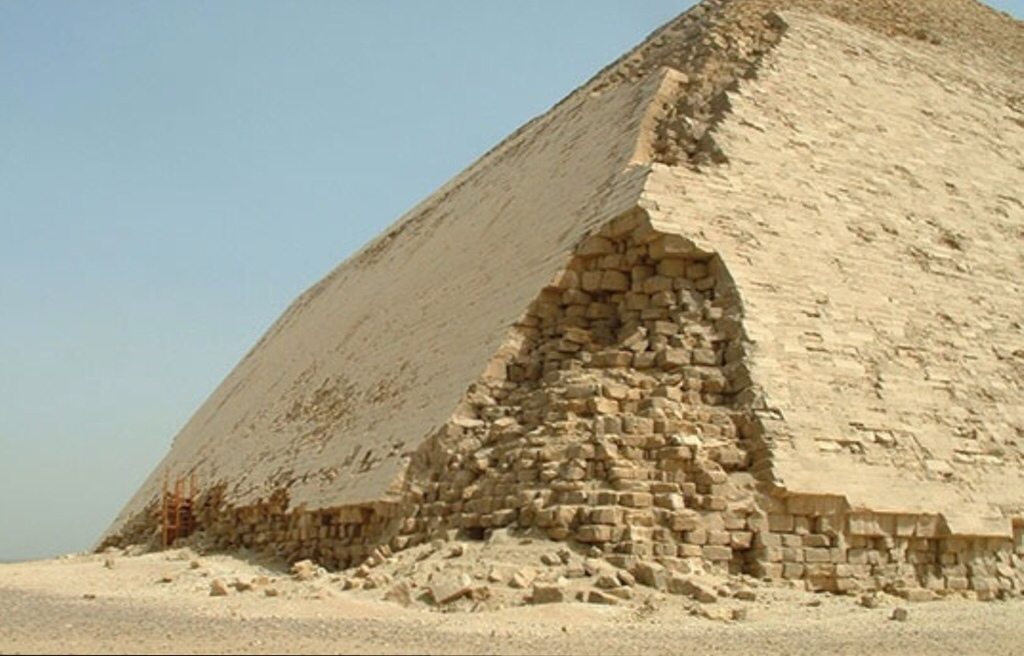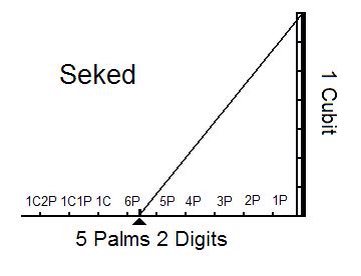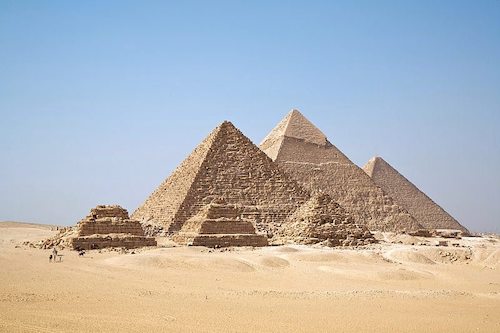
We have discussed above ground burial practices here in the ancient past (see “A History of Ancient Prehistoric Architecture“). All over the world Dolmens, Barrows and Tumulii were used to bury the dead above ground level, beginning at least 11,000 years BCE. I have not discussed Egypt because it represents such a famous instance of pyramid building and death ceremonies. That is not to say that pyramids are a uniquely Egyptian invention. Ziggurats were built by the Sumerians, Babylonians, Elamites, Akkadians, and Assyrians for local religions. Each ziggurat was part of a temple complex which included other buildings. The precursors of the ziggurat were raised platforms (basically Mastabas) that date from the Ubaid period during the fourth millennium BC. Mesoamerica, India, Greece and even the Romans built pyramids. However, the most famous pyramids are the Egyptian pyramids, huge structures built of brick or stone, some of which are among the world's largest constructions. They are shaped as a reference to the rays of the sun. Most pyramids had a polished, highly reflective white limestone surface, in order to give them a shining appearance when viewed from a distance. They appear about 2700 BCE then disappear suddenly in Egypt about 1700 BCE.
After 4000 BC, thanks to the sudden desiccation of the grass plains of the Sahara and an influx of people towards the Nile, there was a substantial increase in population, and village sizes increased accordingly. From around 3500 to 3000 BC there were great and very sudden advances in craftsmanship and technology, which culminated in the working of copper, stone mace heads and ceramics. The first walled towns appeared at Naqada and Heirakonpolis (circa 3300 BC), and were associated with rich tombs, probably the resting places of the rulers of Upper Egypt (to the south). One of these rulers was the first to unite the whole valley, from the first cataract near the Nubian Desert to the Mediterranean, as a single kingdom in about 3400 or 3100 BC.
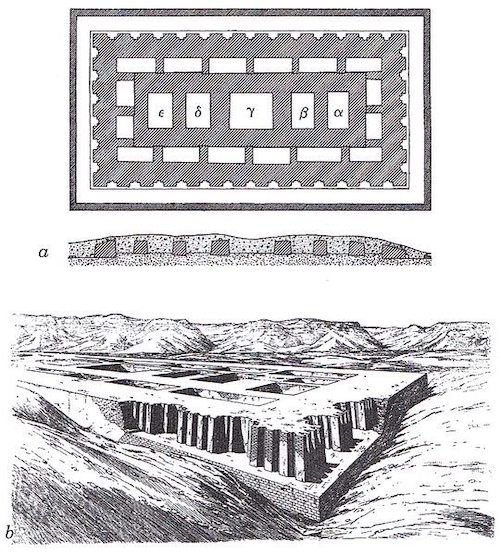
The word Mastaba comes from the Arabic word for a bench of mud, likely because when seen from a distance it resembles a bench. It is also speculated that the Egyptians may have borrowed ideas from Mesopotamia since at the time they were both building similar structures. The earliest known mastabas are at the great cemetery at Saqqara. Mastabas are improved burial structures of tombs from the grave mound of the pre-dynastic period. Neithhotep's dynastic marriage to Narmer, which represents the start of the Early Dynastic Period of Egypt, about 3200 BC, and the unification of Lower and Upper Egypt, may be represented on the Narmer Macehead. In this view Neithhotep was originally a princess of Lower Egypt, before marriage to Narmer (of Upper Egypt). Her underground Mastaba, shown above in a drawing because it is now gone due to erosion, began a trend toward even more elaborate tombs.
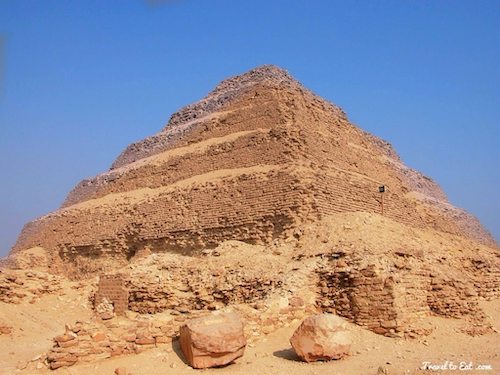
The earliest Egyptian pyramids were step pyramids. Given credit for these impressive structures was chief architect, Imhotep. Imhotep was a great architect who figured a way to structure the stones into a great step layered structure. During the Third dynasty of Egypt, around 2600 to 2650 BCE, the architect Imhotep designed Egypt's first step pyramid as a tomb for the pharaoh, Djoser. This structure, the Pyramid of Djoser, was composed of a series of six successively smaller mastabas, one on top of another. Later pharaohs, including Sekhemkhet and Khaba, built similar structures.
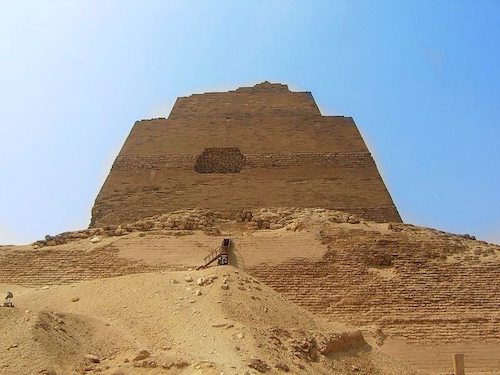
The pyramid at Meidum is thought to have been originally built for Huni, the last pharaoh of the Third Dynasty and was continued by Sneferu. The architect was a successor to the famous Imhotep, the inventor of the stone built pyramid. He modified Imhotep's pyramid design in a way, which is likely to have caused the collapse of the pyramid in conjunction with the decision to extend the construction plan two times in a row, while the pyramid was already under construction. The second extension turned the original step pyramid design into a true pyramid by filling in the steps with limestone encasing. Because of its unusual appearance, the pyramid is called el-haram el-kaddab (Fake Pyramid) in Egyptian Arabic. The Meidum Pyramid seems never to have been completed. Beginning with Sneferu and to the 12th dynasty all pyramids had a valley temple, which is missing at Meidum.
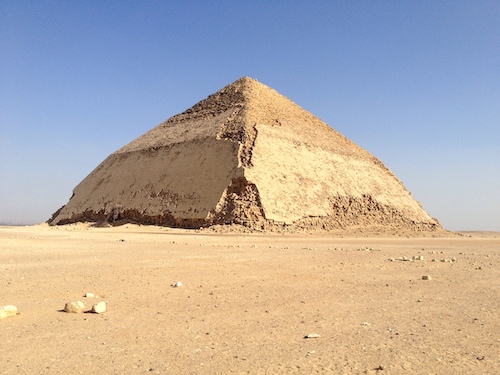
Sneferu was the first king of the fourth dynasty of Ancient Egypt, who according to Manetho reigned for 24 years (2613-2589 BC). Manetho was an Egyptian priest, living in the third century BC, who categorized the pharaohs of dynastic Egypt into 31 dynasties. The most well known monuments from Sneferu’s reign are the three pyramids he is considered to have built in Dahshur, the Meidum pyramid, the Bent Pyramid and the Red Pyramid. Under Sneferu, there was a major evolution in monumental pyramid structures, which would eventually lead to Khufu’s Great Pyramid. In the bent pyramid, the lower part of the pyramid rises from the desert at a 54-degree inclination, but the top section is built at the shallower angle of 43 degrees, lending the pyramid its very obvious “bent” appearance. It has been suggested that due to the steepness of the original angle of inclination the structure may have begun to show signs of instability during construction, forcing the builders to adopt a shallower angle to avert the structure's collapse.
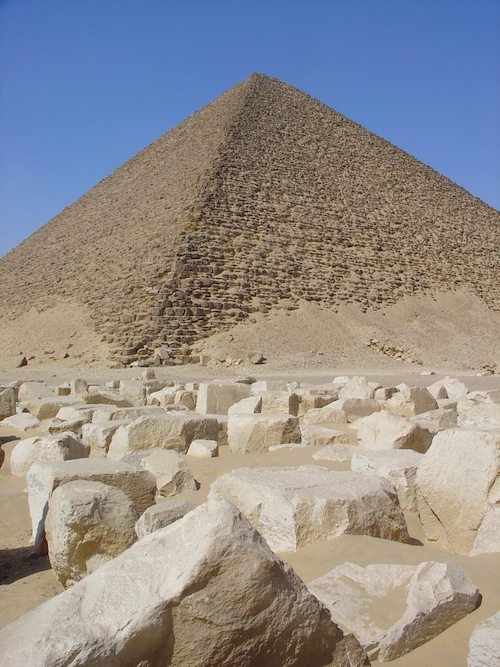
The third pyramid of Pharaoh Snefru, the North “Red” Pyramid, is a single tomb with two smaller chambers. It is the largest of the three major pyramids located at the Dahshur necropolis. Named for the rusty reddish hue of its stones, it is also the third largest Egyptian pyramid, after those of Khufu and Khafra at Giza. It is built at the same shallow 43 degree angle as the upper section of the Bent Pyramid, which gives it a noticeably squat appearance compared to other Egyptian pyramids of comparable scale. It is believed to be the world's first successful attempt at constructing a “true” smooth-sided pyramid and is probably where Sneferu was finally buried.
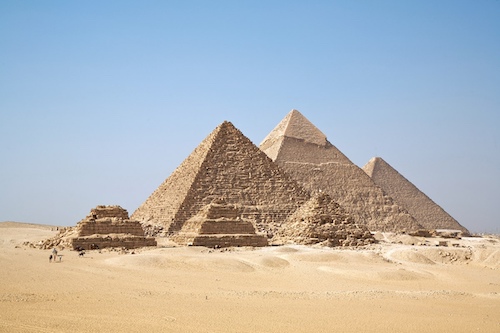
The most famous of all the pyramids of Egypt is the Great Pyramid of Giza built around 2,550 BC. The seked was an ancient Egyptian unit for the measurement of the slope of an inclined surface. The system was based on the Egyptian's linear measure known as the royal cubit. The royal cubit was subdivided into seven palms and each palm was further divided into four digits. The inclination of measured slopes was therefore expressed as the number of palms and digits moved horizontally for each royal cubit rise. Based on the surveys of this structure that have been carried out by Flinders Petrie and others, the slopes of the faces of this monument were a seked of 5 1/2, or 5 palms and 2 digits, which equates to a slope of 51.84° from the horizontal, using the modern 360 degree system. This slope would probably have been accurately applied during construction by way of “A frame” shaped wooden tools with plumb bobs, marked to the correct incline, so that slopes could be measured out and checked efficiently. Many of the smaller pyramids in Egypt have varying slopes, however, like the Great Pyramid of Giza, the pyramid at Meidum is thought to have had sides that sloped by 51.842° or 51° 50' 35″, which is a seked of 5 1/2 palms. Obviously the mechanical reasons for the collapse at Meidum were worked out in the Great Pyramid of Giza. This slope was used to make the height of the pyramid equal to the radius of a circle encompassing the base or 2 times pi.

The last king to build a royal pyramid was Ahmose, the founder of the 18th Egyptian dynasty, with later kings hiding their tombs in the hills, as in the Valley of the Kings in Luxor's West Bank. The pyramid was constructed from sand and rubble and only the usual limestone casing kept the building in shape. It had a base length of 52 m and was about 40 m high. The inclination of the sides was 60°. With the creation of the eighteenth dynasty around 1550 BC, with the accession of Ahmose I, the New Kingdom period of Egypt begins. Ahmose I would succeed in expelling the Hyksos from Egypt and placing the country under a centralized administrative control for the first time since the mid-13th dynasty.

Now that we know a little about the history of pyramids, I would like to introduce Peter James, a mechanical engineer from Southern Wales and managing director of Cintec. During the 1992 earthquake in Egypt, many historically important structures were affected including the Red and Djoser Pyramids. Cintec was called upon by the High Council of Egyptian Antiquities after the pyramids were threatened by collapse. The repairs involved strengthening the connecting burial chamber corridors and ceilings of Egypt’s Red and Step Pyramids. At this point he was asked to consult on the outer casing of the Bent Pyramid. His opinion appeared in Structure magazine:
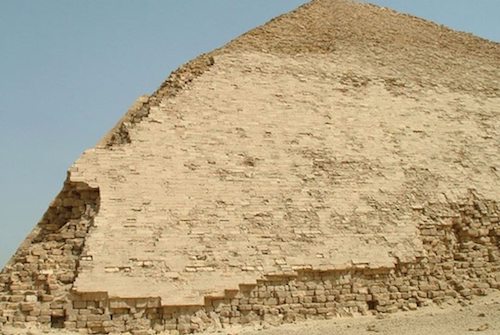
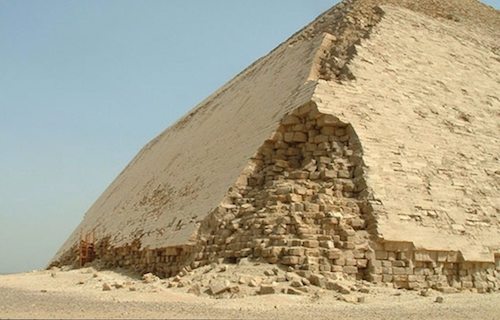
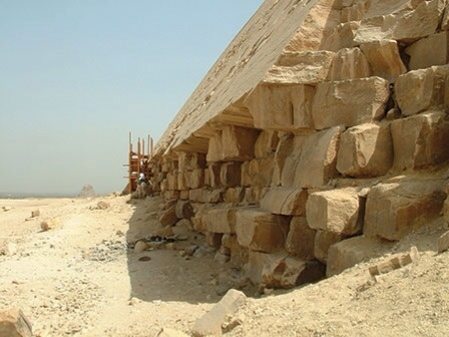
“It is the author’s belief that in the case of the Bent Pyramid — in fact, in the case of all pyramids — the outer casing has been affected by thermal movement. The Bent Pyramid is the only one with any degree of stone casing still attached, making the mechanism of failure apparent. The distress at all of the perimeter edges suggests that the outer casing has expanded from the center outwards, and movement has taken place on all of the extremities.
During the day, the temperature rises to 40°C (104°F) across the face of the outer casing, then at night cools to 3⁰C (37⁰F) because of the lack of cover and exposure to the prevailing winds. This gives an average daily temperature fluctuation of 37°C (67°F). The photographs of the Bent Pyramid show how thermal expansion has caused the blocks to move to the edges, where they have detached. It also shows how individual stones, unsupported, can cantilever and snap off and subsequently fall to the ground.”
He goes on to say that the looting of stone from the pyramids to build Cairo is unlikely since there is lots of limestone in the hills surrounding Cairo. Additionally he states that the Egyptians may have stopped building pyramids because of this problem. I think this this is an interesting theory with the following caveats.
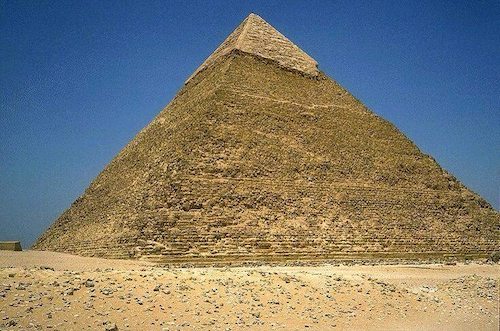
It is a known fact that in 1300 AD, a massive earthquake loosened many of the outer casing stones of the Great Pyramid of Giza, which were then carted away by Bahri Sultan An-Nasir Nasir-ad-Din al-Hasan in 1356 to build mosques and fortresses in nearby Cairo. The stones can still be seen as parts of these structures. Later explorers reported massive piles of rubble at the base of the pyramids left over from the continuing collapse of the casing stones, which were subsequently cleared away during continuing excavations of the site. Could other large earthquakes be responsible for similar results? Could the loss of the facing stones be a combination of earthquakes and thermal effects? It could well be that the thermal effects loosened the casing stones enough to make them susceptible to earthquake damage. I do agree with him that the stones were not removed directly from the structure and in fact some casing remains at the top of the Great Pyramid of Giza.
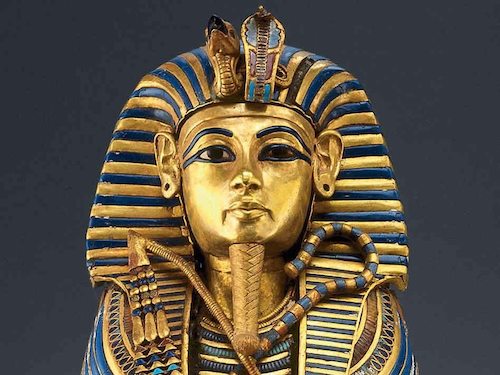
A second assertion is that the Egyptians stopped building pyramids because of this problem. The end of building pyramids occurred at the beginning of the New Kingdom of Egypt and was accompanied by social and political forces quite separate from the physical construction of the pyramids. There is good evidence that security of the graves and their goods was the driving factor to end pyramid building since the first and second intermediary periods had been associated with social unrest and looting. Accordingly, the Valley of Kings was an area suitable for the creation of a secure zone patrolled by special police with the associated temples of the dead pharaohs now created far from the actual graves. I personally do not believe this second assertion.
I found this new paper thought provoking and I hope you will too.
References:
Paper: http://www.structuremag.org/article.aspx?articleID=1668
Kings List: http://www.historyfiles.co.uk/KingListsAfrica/EgyptAncient.htm
Stephen Harvey, Ahmose: http://www.archaeological.org/tours/leaders/stephenharvey

